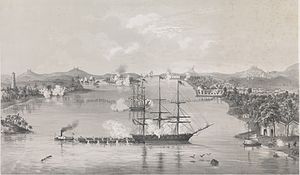| Battle of the Barrier Forts | |||||||
|---|---|---|---|---|---|---|---|
| Part of the Second Opium War | |||||||
 Attack on the Barrier Forts on November 21, showing Portsmouth, and Levant, with men and officers from the steam frigate San Jacinto | |||||||
| |||||||
| Belligerents | |||||||
|
|
| ||||||
| Commanders and leaders | |||||||
|
|
| ||||||
| Units involved | |||||||
|
| Green Standard Army | ||||||
| Strength | |||||||
|
50 marines 237 sailors (on land) 1 steam frigate 2 sloops |
5,000 (garrison force)[1] 3,000 (non-garrison force)[1] | ||||||
| Casualties and losses | |||||||
|
10 killed[1] 22 wounded[1] 2 sloops damaged |
250–500 killed or wounded[2] 176 guns lost[1] 4 forts captured | ||||||
The Battle of the Barrier Forts (also known as the Battle of the Pearl River Forts) was fought between American and Chinese forces in the Pearl River, Guangdong, China in November 1856 during the Second Opium War. The United States Navy launched an amphibious assault against a series of four forts known as the Barrier Forts near the city of Canton (modern-day Guangzhou). It was considered an important battle by the British whose interest lay in capturing Canton.
- ^ a b c d e McClellan, Edwin North (September 1920). "The Capture of the Barrier Forts in the Canton River, China Archived 2017-12-01 at the Wayback Machine". Marine Corps Gazette 5 (3): 262–276.
- ^ Hoppin, James Mason (1874). Life of Andrew Hull Foote, Rear-Admiral United States Navy. New York: Harper & Brothers. p. 120.